
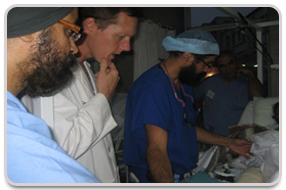 As someone who considers herself honorary Peruvian (it’s a long story) – I was especially proud when I heard about Operation Walk – an organization established by Harpal Singh Khanuja and his wife Maria Khanuja. The non-profit organization is dedicated to providing free knee and hip replacements to underserved people around the world. The concept behind the organization was to perform complicated surgeries on people in developing countries, “where arthritis progresses to its end stages and reconstructing joints becomes technically challenging.” Often times, it is people who are most at need who cannot afford the surgery. A news article discusses Operation Walk’s recent trip to Lima, Peru where they performed 48 surgeries to replace knee and hip joints. Here on TLH we like to highlight examples of seva – this is another important example of what it means to do selfless service,
As someone who considers herself honorary Peruvian (it’s a long story) – I was especially proud when I heard about Operation Walk – an organization established by Harpal Singh Khanuja and his wife Maria Khanuja. The non-profit organization is dedicated to providing free knee and hip replacements to underserved people around the world. The concept behind the organization was to perform complicated surgeries on people in developing countries, “where arthritis progresses to its end stages and reconstructing joints becomes technically challenging.” Often times, it is people who are most at need who cannot afford the surgery. A news article discusses Operation Walk’s recent trip to Lima, Peru where they performed 48 surgeries to replace knee and hip joints. Here on TLH we like to highlight examples of seva – this is another important example of what it means to do selfless service,
“It was very rewarding to do this work for people and not expecting anything in return,” Harpal Singh said. “It’s really their gratitude that you cherish the most.”
The organization’s goal is to replicate the Peru mission to Panjab where the need is also great (some of which can be attributed to the chemical farming of the Green Revolution).
Well, it seems like the sex ratio in Punjab is not improving despite the number of trees Mrs. Badal is planting and the SGPC’s desire to raise unwanted girl children.
The Tribune reports:
In 2001, the census of India recorded Punjab’s sex ratio at 876 females for 1,000 males, one of the worst in the country. The preliminary findings of a Lucknow-based agency AMS engaged by the government to assess the current situation shows that sex-ratio in many districts of the state has plummeted further.
First, AMS’s study has called out the Punjab government’s bluff in data collection. Apparently, the data collected by Punjab government agencies painted “… an unbelievably rosy picture of the situation”. The Social Security Department and Health Department have reported two different results. These results also do not match those of AMS.
If Baldev Mutta’s cellphone rings in the middle of a meeting, he picks it up. If it beeps over dinnertime or at midnight, he answers it. And if he has to go out to pick up a woman and find her a spot at a shelter at 3 a.m., he will do it. “It can mean the difference between life and death for a woman,” said Mutta, executive director of Punjabi Community Health Services in Brampton. “They are abused and don’t have anywhere else to go. This agency is their lifeline.” [link]
The Punjabi Community Health Services is an organization based in Brampton, Canada which provides various services to Punjabi women who have been abused. Instead of waiting for women to turn up at their doorstep, this organization takes a proactive approach by sending workers into the community to speak with abused women. They visit Gurdwaras and community centers to find women in distress. At times they must speak with the women secretly at doctor’s appointments, grocery stores, even parking lots, so their families don’t find out.
::
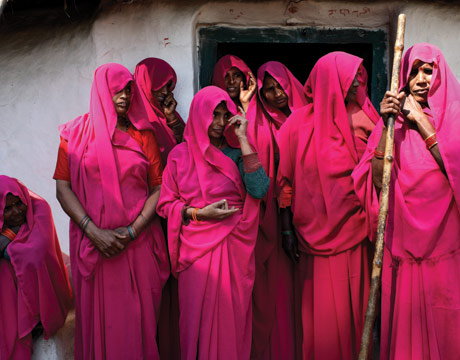 In related news, I recently read an article about the “Gulabi Gang” in an issue of Marie Claire which appeared on New America Media yesterday aswell. The Gulabi Gang are a group of women in India who have come together to fight against abuse. When local officials refused to take action against an alleged rapist, scores of pink-sari-clad women stormed the police station, demanding action – and thus, became know as the Gulabi Gang. For example, when Sampat Pal Devi learned that a friend had been beaten by her alcoholic husband and that the local police, chronically indifferent to violence against women, had looked the other way, something inside her snapped. In an effort to fight back, she gathered dozens of her female neighbors, armed them with sticks, and taught them how to fight back. Together, the self-declared Gulabi Gang have beaten up accused rapists, profligate officials, and husbands who’ve abandoned their wives.
In related news, I recently read an article about the “Gulabi Gang” in an issue of Marie Claire which appeared on New America Media yesterday aswell. The Gulabi Gang are a group of women in India who have come together to fight against abuse. When local officials refused to take action against an alleged rapist, scores of pink-sari-clad women stormed the police station, demanding action – and thus, became know as the Gulabi Gang. For example, when Sampat Pal Devi learned that a friend had been beaten by her alcoholic husband and that the local police, chronically indifferent to violence against women, had looked the other way, something inside her snapped. In an effort to fight back, she gathered dozens of her female neighbors, armed them with sticks, and taught them how to fight back. Together, the self-declared Gulabi Gang have beaten up accused rapists, profligate officials, and husbands who’ve abandoned their wives.
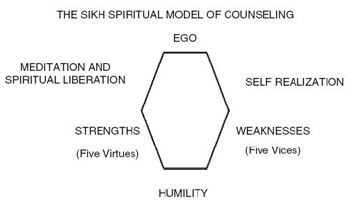 Despite the rich linguistic flexibility of Punjabi, it is telling that we do not have a single term for ‘depression.’ Mental health has been an ongoing conversation since the inception of the blog, repeatedly highlighted by Sundari and others. Often treatment is not sought and if it is sought it is usually terminated early as clients do not feel health professionals understand their world-view.
Despite the rich linguistic flexibility of Punjabi, it is telling that we do not have a single term for ‘depression.’ Mental health has been an ongoing conversation since the inception of the blog, repeatedly highlighted by Sundari and others. Often treatment is not sought and if it is sought it is usually terminated early as clients do not feel health professionals understand their world-view.
While we have numerous issues facing the Sikh community, there are few channels for those seeking mental health assistance. Thus, I was happily surprised when I came upon a medical article, titled “The Sikh Spiritual Model of Counseling.”
I reproduce the abstract in its entirety:
In accordance with the holistic principles of modern medicine, this paper will present the Sikh religious and spiritual view of mental health. With the continuing migration of a large number of South Asians, especially the Sikhs, to Western countries, mental health professionals should be aware of their clients’ world-view and cultural/religious specifi c models of counseling. Use of Sikh spirituality can reduce stress; help in treating psychosomatic disorders; and improve mental health of the individual and of the community. This paper will conclude that as the Sikh religion is a universal religion, everyone can use Sikh spirituality.
Dr. Kala Singh, the author of the article, is a physician that works as a multicultural mental-health liaison at Vancouver Coastal Health. I also want to personally thank the author for sending me a copy of his article!
The conflict between modern ideals of beauty and the requirements of the Sikh faith came up in a prior post. Recently, Sukhmandir Kaur Khalsa spoke eloquently on this issue in an Arkansas publication. Excerpted below are Khalsa’s perspectives on hair, beauty, and truth.
“I liken the inherent programming of the body’s ability to grow hair to truth,” Kaur said. “Truth always asserts itself and cannot be covered for long by a falsehood. Similarly, we can shave, pluck, bleach, color, trip, tweeze, and wax hair, but it will continue to be true to its programming. The hair follicle must be killed or removed to prevent hair from appearing on the face or body. . .”
Kaur had trouble with her own self-esteem in the beginning. “I had a lot of difficulty embracing my natural identity,” she said, “until I realized through a series of experiences that I was disgracing and defacing my God-given natural beauty.”
She said she developed a high degree of self-confidence through her self-acceptance. “I realize,” she said, “that many women do not have the confidence to face the world without masking themselves with cosmetic makeup and procedures such as hair removal. . .” [link]
Last year we heard the story of Lakhwinder Kahlon, a Delta, B.C. man who had been arrested for the murder of his two-year-old daughter, Rajwinder. This past week, Lakhwinder received an automatic life term when he pleaded guilty to second-degree murder. The father, who admitted to strangling and decapitating his daughter, will have to spend 11 years in jail before he can apply for parole. A few days ago, the judge released the 911 call of Lakhwinder admitting to the horrific act. The call is chilling – Lakhwinder tells the operator that he killed his daughter by cutting her neck, that he is depressed, and that the police should come and arrest him.
While it is hard to come up with any explanation to describe why Lakhwinder murdered his daughter, several suggestions were made. In an immediate reaction to hearing the news, there was speculation that Lakhwinder was upset that he only had daughters. This suggestion was vehemently denied by Lakhwinder’s wife and the community was quick to denounce female inequality.
Outrage and sorrow have poured out in radio talk shows and letters to newspapers, including one from Tara Diakow of Richmond, B.C., who wrote: “Who will battle against the ugly stereotype that Rajvinder Kahlon’s death has unfortunately brought to many people’s minds – the seemingly disposable position of Indo-Canadian women?” In a forceful statement on Monday, Liberal MP Ujjal Dosanjh used the case to denounce the practice of aborting female fetuses, which he says continues to take place in Canadian families. [link]
Today is World AIDS Day. The theme of this year’s World AIDS Day is leadership and efforts are focused on prevention. Indeed, on this 20th anniversary of World AIDS Day, President-elect Obama has stated that his administration will focus on prevention and treatment for at-risk communities in the U.S. and rest of the world. World AIDS Day, is the day when organisations from around the world come together to bring attention to the global AIDS epidemic. In 2007, there were 33 million people living with HIV/AIDS. Women account for 50% of all adults living with HIV worldwide and young people (under 25 years old) account for half of all new HIV infections worldwide.

In line with the theme of leadership which is the message of this year’s anniversary, I came across AIDS Jagoo – an effort by Mira Nair and the Bill and Melinda Gates Foundation – to bring together Indian directors and actors to create four short dramatic films that aim to “dismantle myths and misconceptions of HIV/AIDS.” The four AIDS Jagoo films come from various parts of India – each its own genre and with a different point of view on the HIV/AIDS epidemic.
Migration, directed by Mira Nair, discusses HIV/AIDS from an urban/rural angle. Blood Brothers, directed by Vishal Bhardwaj, follows the journey of a young man from a positive HIV diagnosis to the eye-opening conclusion. Prarambha (The Beginning), directed by Santosh Sivan, deals with society’s prejudices against people with AIDS through the journey of a young boy’s search for his mother. Positive, directed by Farhan Akhtar, shows a family coping with AIDS and reveals the courage they bring to overcome the tragedy. Most of the films have subtitles. Hopefully you’ll be able to watch some or all of these and join the global community in remembering those impacted by HIV/AIDS.
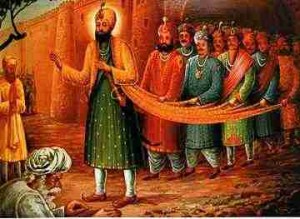 Many Sikhs participate in the celebrations of Diwali, the festival of light, without actually knowing what the significance of the date is in Sikh history. I can admit that for a long time, Diwali didn’t hold much importance for me because I didn’t fully understand why we celebrated it. In fact, today is not only Diwali but also marks Bandi Chor Diwas a day where Sikhs join together to celebrate the release of the sixth Nanak, Guru Hargobind Ji from imprisonment. The historic event itself should be acknowledged with significance – particularly the fact that upon order of his release from Gwalior Fort, Guru Hargobind Ji refused to leave unless the 52 princes who had also been imprisoned would also be allowed to leave. Thinking of others’ rights were more important than simply thinking of his own.
Many Sikhs participate in the celebrations of Diwali, the festival of light, without actually knowing what the significance of the date is in Sikh history. I can admit that for a long time, Diwali didn’t hold much importance for me because I didn’t fully understand why we celebrated it. In fact, today is not only Diwali but also marks Bandi Chor Diwas a day where Sikhs join together to celebrate the release of the sixth Nanak, Guru Hargobind Ji from imprisonment. The historic event itself should be acknowledged with significance – particularly the fact that upon order of his release from Gwalior Fort, Guru Hargobind Ji refused to leave unless the 52 princes who had also been imprisoned would also be allowed to leave. Thinking of others’ rights were more important than simply thinking of his own.
To me, the day is a reminder of the concept of Sarbat da Balla, or the welfare of all. Sarbat da Balla is a guiding principle that hopefully makes our words and actions bring about positive change to the greater good. As we approach the upcoming election (7 days to go!), it is these principles that should help advise us on those issues that affect not just ourselves but the collective good. While the economy is the principal concern on the minds of most voters, healthcare is an important issue that will also sway votes in a meaningful way.
A recent Kaiser Family Foundation poll shows that voters agree that in the face of a struggling economy “it is more important than ever to take on health care reform.”
Among Democrats, expanding coverage for the uninsured ranks second, named by 35 percent of those voters. Coverage also ranks second for political independents, named by a somewhat smaller proportion (23 percent). Relatively few Republicans (9 percent) name coverage as a health care priority. Most Democrats (69 percent) and half of independents (51 percent) think that universal coverage would help the overall economic situation in the United States, while only 34 percent of Republicans agree. [link]
Sundari’s recent post, addressing the portayal of Sikhs in an ad for the upcoming Spinning Wheel festival, brings up an interesting tension for Sikh women- the conflict between modern ideals of beauty, and the requirements of the Sikh faith.
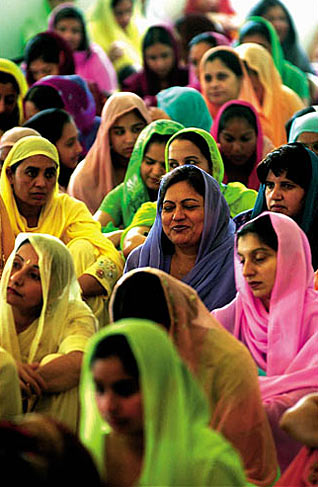 Generally (and unfortunately) women tend to value themselves (whether consciously or unconsciously) according to social valuations placed upon women… which revolve mostly around ideas of outer beauty- trends which vary a bit across region and time, but are all generally superficial. Women who have completely overcome this unconscious embrace of ideals of beauty are extremely rare. For those who think is untrue- think about how many times you’ve heard a female friend talk about the bad day she was having- many of the complaints probably had something to do with the way she felt she looked that day (that might not be the best example, but it’s the first that comes to mind). How we feel is too closely related to how we feel we look.
Generally (and unfortunately) women tend to value themselves (whether consciously or unconsciously) according to social valuations placed upon women… which revolve mostly around ideas of outer beauty- trends which vary a bit across region and time, but are all generally superficial. Women who have completely overcome this unconscious embrace of ideals of beauty are extremely rare. For those who think is untrue- think about how many times you’ve heard a female friend talk about the bad day she was having- many of the complaints probably had something to do with the way she felt she looked that day (that might not be the best example, but it’s the first that comes to mind). How we feel is too closely related to how we feel we look.
These social valuations of beauty are especially problematic for Sikh women in particular because these values are totally opposed to an important part of Sikh identity- our kesh. They are also problematic for all women because we’re not valuing what really matters- our thoughts, ideas and actions which really create who we are- but a superficial farce. Finally, these valuations are problematic because many modern ideals of beauty are unhealthy (but enough has been said about these last two points in general gender conversations that I don’t want to dwell on them).
The challenges and overt racism that Sikh men face in the US today because of their kesh are undeniable. But the solutions that address men’s kesh (mostly political responses, creating social awareness) don’t carry over as solutions for women.
In an effort to better understand the food habitats of Panjabi immigrants, Canadian researchers conducted a three-year study on the ingredients used in daily Panjabi meals and food choices made by Panjabi families.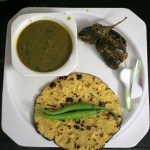
Gwen Chapman, study leader and British Columbia University nutrition professor, stated:
“Since cardiovascular diseases and type II diabetes are more prevalent among Indians and they are linked to food habits, we wanted to understand what ingredients went into daily Punjabi or Indian meals.”
An important part of study was also understanding how cultural affiliations play a role in Panjabi immigrant food choices.
Researchers found that “in Punjabi families in British Columbia … separate meals are often prepared to accommodate elders who need traditional roti, daal and subji, and younger family members who prefer to balance Indian and “Canadian” foods.”
While reading this article I thought about how these food choices actually play out in immigrant Panjabi homes across North America. I remember the rotis without butter for those who have high cholesterol and the weekend meal of burger and fries for us “American” kids. There were also the interesting “masalaa” pastas, lasagnas, and pizzas that had a “Panjabi” twist (i.e. tons of garam-masalaa). I recall uncles’ refusing to eat “kaa-foos” prepared by their wives, aunties making tofu-sabiji, and mothers’ substituting olive oil for vegetable oil when making tarkas. Many of these food choices were an effort to provide more healthy meals as a “preventive” form of action against heart disease and diabetes; while others were made to satisfy taste-buds.
So I was wondering what interesting food choices have you seen Panjabi families make in the Diaspora both to satisfy taste-buds and become more healthy?
We are only beginning to hear about the prevalence of postpartum depression in the larger community, so it comes as no surprise to me that we hear about it even less within the South Asian community. Recent research suggests that Indian women, particularly new immigrants, may be at a higher risk of postpartum depression than their non-Indian counterparts. Experts suggest isolation stemming from the immigrant experience and a lack of the traditional support system often found in the home countries, as reasons for increased prevalence among Indian women.
In the United States, about one in 10 women suffers from postpartum depression (PPD). South Asian women may be at a higher risk for PPD, due to the impact of acculturation and cultural customs including factors such as arranged marriage and the gender of the child.
A groundbreaking 2007 study published in the Journal of Obstetrics and Gynecology concluded that 28 percent of Indian American women suffered mild symptoms of postpartum depression and 24 percent suffered major symptoms. The paper-titled “Immigrant Asian Indian Women and Postpartum Depression” is the only study of Indian American women and postpartum depression. [link]
Dr. Nirmaljit Dhami, medical director of the new Maternal Outreach Mood Services program at El Camino Hospital in Mountain View, Calif., says that post-birth, many women present symptoms of tearfulness and crying. Sadness, emptiness, feeling overwhelmed, having a short temper, appetite changes and withdrawal from family and friends are all symptoms common to postpartum depression. [link]
Langa(w)riters have posted on AIDS/HIV infection amongst Sikh women here and here. We have discussed issues around support groups and causes of infection. One of the number one risk factors for contracting HIV/AIDS for Punjabi Sikh women is marriage. Many women are infected by their husbands who are intravenous drug addicts and/or clients of prostitutes. Not only are these women’s lives reaped with more havoc at no fault of their own, but there is also an insurmountable amount of stigma these women endure.
This past week, a Sikh woman, Kiranjit Kaur, stood up with tremendous strength and bravery to help combat this stigma. She become the poster-woman for people living with HIV/AIDS in Malaysia. At the age of 35, Kaur has decided to put her face to this disease because “I am here to help the ‘positive’ community and empower them and tell them they are not alone.”
Kiranjit Kaur contracted HIV in 1996 through her husband who was a former drug addict and has since passed away.
After contracting the disease she began working full-time with the Asian Pacific Council on AIDS Services as an advocate for other HIV/AIDS patients.
Is the tipping point (the level at which the momentum for change becomes unstoppable) approaching for a change in attitudes towards the value of women and need to have sons?
There has been a widespread, public movement condemning sex-selection by the government, ngos, and others in the community for some time now (this hard-hitting song by Sarabjit Cheema is a must-see). Since Amartya Sen’s articulation of ‘missing women,’ the rights of women in developing countries have been at the forefront of international agendas. In a recent development, Sunita Rao, an Indian pop singer, has released a song condemning sex-selective abortion and become the spokesperson for the LAADLI campaign, funded by the United Nations Population Fund.
Suneeta Rao’s latest album WAQT’s press conference was held in Hotel Palace Heights, New Delhi. It was on behalf of United Nations Population Fund (UNFPA). The singer is the official spokesperson of the Laadli campaign of UNFPA that focuses on the pleasure and pride of having a daughter and motivates people to fight injustice against the girl child. ‘The video of the first song in my album ‘Sun Zara’ is a dedication to all girls, Suneeta said, UNFPA has gratefully supported in making the video of this album. According to United Nations Population Fund, “This video has been made for the Girl Child, to address the issue of Sex Selection and to help stop female feticide”. [link]
The song mentioned above, Sun Zara:
I found this interview with the revered Fauji Singh ji, after completing the Edinburgh daur- a mere chabi (26) miles to be so endearing.
He has a message for the nau-jawan and at the end (it kind of got cut off, but he seems happy that the nau-jawan, both boys and girls, are running these days)…

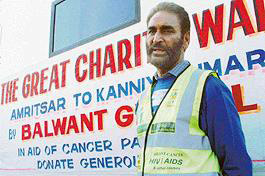 72 year old Balwant (“Bobby“) Singh Grewal is walking 500 miles (800 km) from the Scottish Parliament Building in Edinburgh to the House of Parliament in London in five weeks. He began on June 5th and is scheduled to finish on July 9th. He is raising 100 million pounds for cancer research. (If you can’t tell by the bolded format, I’m rather impressed by this feat.)
72 year old Balwant (“Bobby“) Singh Grewal is walking 500 miles (800 km) from the Scottish Parliament Building in Edinburgh to the House of Parliament in London in five weeks. He began on June 5th and is scheduled to finish on July 9th. He is raising 100 million pounds for cancer research. (If you can’t tell by the bolded format, I’m rather impressed by this feat.)
Grewal is undertaking the walk to raise one million pounds for research into bowel cancer and other bowel diseases at St Mark’s Hospital, Harrow, a hospital unique in the U.K. [link]
This isn’t the first time Bobby Grewal has walked to raise large sums of money for medical research.
In 2001, he ran the London Marathon in just over five hours, and in 2004-5 (aged 68), he completed a walk covering 2,500 miles across India from the North-West frontier to the deep South…The walk raised 100,000 pounds for research into cancer and AIDS. [link]
Do you think Bobby Grewal is in the same class as the legendary Fauja Singh?
The Punjab government has finally allocated funds to assess the breadth of farmer suicides in the state.
The Punjab Government seems to have finally woken up to the need of having a census on farmers’ suicides in the state. The state government, it is learnt, has the [sic] entrusted the arduous task of completing the census to the Punjab Agricultural University. As per Dr R.S. Sidhu, head of the Department of Economics, PAU, “The state government has asked us to do the work and we have taken it up as a research project. Though whole of Punjab is to be covered under the study, the state government has asked us to do a pilot project in two districts of Punjab, Gurdaspur and Sangrur initially.
The census will be conducted by the Punjab Agricultural University (PAU), based in Patiala Ludhiana. During the first phase of the survey, PAU will conduct a door to door survey in about 1,500 villages in Gurdaspur and about 575 villages in Sangrur out of the 12,000 villages in Punjab. The report from this initial phase is set to be completed in four months from the beginning of the survey, which is set to begin in the next couple of weeks.
The census will take into account farmer suicides occurring after April 1, 2005, excluding suicides of farm laborers.
Rising pesticide and fertiliser costs, shrinking land holdings, declining soil fertility and heavily-subsidized farming in wealthier countries are some of the factors blamed for these suicides.
Those in Punjab who don’t have access to hospitals and licensed doctors often seek cures from quacks posing as medicine men and the plethora of cure-all medication sold by hawkers at bus stops. In central California too, illegal immigrants turn to traditional healers.
Immigrants interviewed amid the vineyards of Madera and the cantaloupe fields of Mendota said they had faced numerous obstacles to pursuing conventional medical care. Above all, they said, was cost, but other factors included fear of deportation, long waits for treatment in medically underserved areas, and barriers of culture and language.
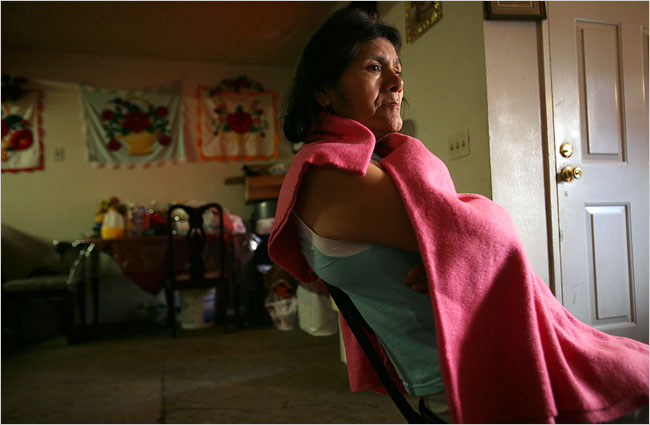 This article focuses on the Hispanic immigrant community, but the issue it raises applies to Punjabi Sikh legal and illegal immigrants as well. I would venture that some Punjabi immigrants (legal or illegal), because of the high cost of American health care, would prefer the care of a member of the community with questionable credentials to an emergency room of seemingly hostile nurses and doctors. We’ve mentioned many homeopathic medicines that many people find to be great for preventative and healing purposes. But there is a risk to traditional medicines too- that patients who may have serious illnesses will postpone diagnosis, aggravating an illness that could have been more easily addressed if diagnosed earlier.
This article focuses on the Hispanic immigrant community, but the issue it raises applies to Punjabi Sikh legal and illegal immigrants as well. I would venture that some Punjabi immigrants (legal or illegal), because of the high cost of American health care, would prefer the care of a member of the community with questionable credentials to an emergency room of seemingly hostile nurses and doctors. We’ve mentioned many homeopathic medicines that many people find to be great for preventative and healing purposes. But there is a risk to traditional medicines too- that patients who may have serious illnesses will postpone diagnosis, aggravating an illness that could have been more easily addressed if diagnosed earlier.
Recently, I read a 1997 research article in the Journal of Marriage and Family on “Fathering And Acculturation: Immigrant Indian Families With Young Children”, which stated that:
“Older fathers spent less time playing with their child … more educated fathers engaged more in disciplining than other fathers, and that more father-child play occurred when there were fewer children in the home and when the target child was the only child …”.
I was excited to read a study that focused on fathers as parents and not just mothers, particularly in the “Indian” context. Generally when it comes to “Indian” parenting, the focus is on the mothers because they are traditionally viewed as primarily responsible for their children’s day-to-day emotional and social well-being. Fathers in the parenthood are often given little notice, as their duties are usually associted wtih providing financial security.
However, we know parenting is far more complex and nuanced. Gender roles in a family are never quite so separate and distinct. Even though many of our fathers were not involved in our daily predicaments, kept a distance, and focused on making money, they still influenced our emotional and social upbringing through discipline, protection, and/or silence.
PBS is currently running a fascinating documentary called Unnatural Causes which explores the racial and socioeconomic inequalities in health. Do we all have an equal chance for health? Is this inequality making us sicker? These are the questions that build the foundation for this seven-part documentary that looks at the root causes of health and illness and goes beyond popular conceptions linking health to medical care and explores evidence of more powerful determinants such as the social conditions in which we are born, live and work.
We spend more than twice the average rich country spends per person on medical care. Yet we have among the worst disease outcomes of any industrialized nation – and the greatest health inequities. At every step down the socio-economic ladder, African Americans, Native Americans and Pacific Islanders often fare worse than their white counterparts. The unequal distribution of social conditions – and their health consequences – are not natural or inevitable. They are the result of choices that we as a community, as states, and as a nation have made, and can make differently. Our international health status has fallen radically in the last few decades. In 1980, we ranked 14th in life expectancy; by 2007, we had fallen to 29th. [Link]
One issue that is particularly interesting is how racism adversely impacts an individual’s and ultimately an entire community’s health. Researchers are circling in on a way to explain the presence of worse health outcomes among minorities and suggest that the chronic stress of racism can be embedded in the body, taking a heavy toll on people of color. The researchers suggest that when you have a reaction to a situation in your life that makes you anxious or gets you stressed out, you not only have a psychological or emotional reaction but you also have a biological reaction. If that stress is chronic, over time it creates wear and tear on your body’s organs and systems and thus, causing illness. Another issue of interest is the fact that immigrants, who are often poorer, tend to be healthier than the average American. However, the longer they live here, the worse their relative health becomes, even as their economic status improves. Children of immigrants are particularly at risk for obesity, heart disease, and mental illness. The documentary explores what it is about new immigrant communities that shield people from poor health and how this protective shield erodes over time.
Both these issues are relevant to the Punjabi Sikh community. It’s important to look at the social conditions as mentioned in this documentary to help us understand the high rates of heart disease, obesity, diabetes, and mental illness that are impacting our community.
Unnatural Causes airs on PBS on Thursdays through April 17th.
In the past few months, New America Media has reported on the treatment and exploitation of Punjabi farmworkers and the cultural isolation they are experiencing. This is not a new issue nor is it unique to Punjabi farmworkers, but it is a growing trend that is beginning to be addressed by workers’ rights organizations. One of the most recent articles by NAM speaks about the exploitation of farmworkers who are here on temporary visas.
In California’s rural Central Valley farmland, there are rumors that American farmers of Indian origin are, in an ironic twist, also abusing the temporary work visa program. In 2005, the case against a prominent Yuba City, Calif. grower, Harbans Bath, was settled in favor of his workers. He had been accused of housing hundreds of temporary workers, including some of his own relatives, in trailers, pesticide storage sheds and other structures that didn’t meet housing safety and health standards. According to Lee Pliscou, a lead attorney at California Rural Legal Assistance, the workers weren’t provided with food – instead, they were made to eat the crops they picked. They were also told that they wouldn’t be paid until the end of the harvest season. The workers from the Indian state of Punjab readily accepted this condition, since that is how payment has often worked on Punjabi farms.
An interesting statistic suggests that while South Asian growers account for less than one percent of the farmers in California, records show that they have been the targets of five percent of civil actions. Related to labor violations, Punjabi farmworkers are also experiencing cultural isolation that is adversely impacting their health. California governmental agencies that are responsible for protecting the rights of farm workers do not have Punjabi-speaking outreach workers. Many farm-working Punjabis often endure hazardous conditions, substandard pay, and little or no access to health care. Indian American growers in California have paid more than $15,000 in field violation fines to county agricultural commissioners in the past two years.

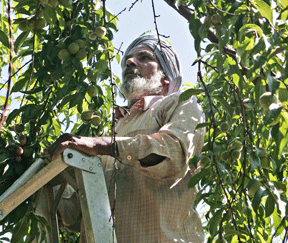 In California’s rural Central Valley farmland, there are rumors that American farmers of Indian origin are, in an ironic twist, also abusing the temporary work visa program. In 2005, the case against a prominent Yuba City, Calif. grower, Harbans Bath, was settled in favor of his workers. He had been accused of housing hundreds of temporary workers, including some of his own relatives, in trailers, pesticide storage sheds and other structures that didn’t meet housing safety and health standards. According to Lee Pliscou, a lead attorney at California Rural Legal Assistance, the workers weren’t provided with food – instead, they were made to eat the crops they picked. They were also told that they wouldn’t be paid until the end of the harvest season. The workers from the Indian state of Punjab readily accepted this condition, since that is how payment has often worked on Punjabi farms.
In California’s rural Central Valley farmland, there are rumors that American farmers of Indian origin are, in an ironic twist, also abusing the temporary work visa program. In 2005, the case against a prominent Yuba City, Calif. grower, Harbans Bath, was settled in favor of his workers. He had been accused of housing hundreds of temporary workers, including some of his own relatives, in trailers, pesticide storage sheds and other structures that didn’t meet housing safety and health standards. According to Lee Pliscou, a lead attorney at California Rural Legal Assistance, the workers weren’t provided with food – instead, they were made to eat the crops they picked. They were also told that they wouldn’t be paid until the end of the harvest season. The workers from the Indian state of Punjab readily accepted this condition, since that is how payment has often worked on Punjabi farms.